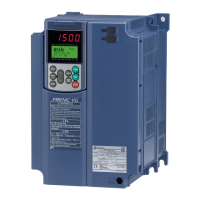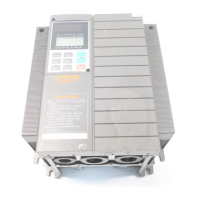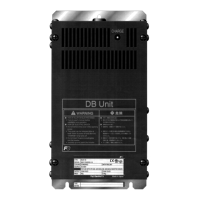12.3 Common Specifications
12-22
Item Explanation Remarks
Control
Control method
• V/f control
• Vector control without speed sensor (Dynamic torque vector)
• V/f control, with slip compensation
• V/f control, with slip sensor (PG option)
• V/f Control with speed sensor (+Auto Torque Boost)(PG option)
• Vector control with speed sensor (PG option)
• Vector control without magnetic pole position sensor
VF
IM-SVC
VF with SC
IMPG-VF
IMPG-ATB
IMPG-VC
PM-SVC
Voltage/frequency
characteristics
• Possible to set 80 to 240 V / 160 to 500 V at base frequency and at maximum
output frequency.
• Non-linear V/f setting (3 points):
Free voltage (0 to 240 V / 500 V) and frequency (0 to 500 Hz) can be set.
Torque boost
• Auto torque boost (For constant torque load)
• Manual torque boost: Torque boost value can be set between 0.0 and 20.0%
• Select application load with the function code. (Variable torque load or constant
torque load)
Starting torque
Three phase 400 V class series
• 200% or above, reference frequency 0.5 Hz (HHD-mode inverters of
FRN0072E2■-4 or below)
150% or above, reference frequency 0.5 Hz (HHD-mode inverters of
FRN0085E2■-4 or above)
• 120% or above, reference frequency 0.5 Hz (HND/ND mode)
• 150% or above, reference frequency 0.5 Hz (HD mode)
Three phase 200 V class series
• 200% or above, reference frequency 0.5 Hz (HHD-mode inverters of
FRN0069E2■-2 or below)
• 120% or above, reference frequency 0.5 Hz (HND-mode inverters of
FRN0069E2■-2 or below)
Single phase 200 V class series
• 200% or above, reference frequency 0.5 Hz (HHD-mode inverters of
FRN0011E2■-7 or below)
Base frequency 50 Hz, with slip compensation and auto torque boost active
Start/stop operation
Keypad: Start and stop with and keys (Standard keypad)
Start and stop with / and keys (Optional multi-function keypad)
External signals (digital inputs):
Forward (Reverse) rotation, stop command (capable of 3-wire operation),
coast-to-stop command, external alarm, alarm reset, etc.
Link operation: Operation through RS-485 (built-in as standard), CANopen (built-in as
standard) or field bus (option) communications link
Switching run command: Remote/local switching, link switching
Frequency setting
Keypad: Using and keys
External potentiometer: Using external frequency command potentiometer.
(External resistor of 1 to 5 kΩ 1/2 W)
Analog input: 0 to ±10 VDC (±5 VDC)/ 0 to ±100% (terminal [12]),
0 to +10 VDC (+5 VDC)/ 0 to +100% (terminal [12])
4 to 20 mADC/ 0 to +100% (terminal [C1] (C1 function))
4 to 20 mADC/ 0 to ±100% (terminal [C1] (C1 function))
0 to 20 mADC/ 0 to +100% (terminal [C1] (C1 function))
0 to 20 mADC/ 0 to ±100% (terminal [C1] (C1 function))
0 to +10 VDC (+5 VDC)/ 0 to +100% (terminal [C1] (V2 function)),
0 to +10 VDC (+5 VDC)/ 0 to ±100% (terminal [C1] (V2 function))
UP/DOWN operation: Frequency can be increased or decreased while the digital
input signal is ON.
Multistep frequency: Selectable from 16 different frequencies (step 0 to 15)
Pattern operation: The inverter runs automatically according to the previously
specified run time, rotation direction, acceleration/deceleration
time and reference frequency. Up to 7 stages can be specified.
Link operation: Operation through RS-485 (built-in as standard), CANopen (built-in as
standard) or field bus (option) communications link
Frequency setting: Two types of frequency settings can be switched with an external
signal (digital input). Remote/local switching, link switching

